10.10.2006
Game XI V.Topalov - V.Kramnik
1.d4 d5 2.c4 c6 3.Nf3 Nf6 4.e3 Bf5 5.Nc3 e6 6.Nh4 Bg6 7.Nxg6 hxg6 8.Rb1
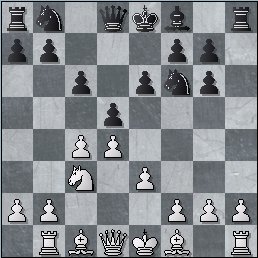
Another surprise with the idea similar to game 9, white is trying to restrict black position, c4-c5 is underway. Topalov demonstrates us indeed in this match the whole richness and diversity of methods of fighting in chess in all senses.. 8...Nbd7 9.c5 a5 10.a3 e5 11.b4 axb4 12.axb4 Qc7 13.f4!? This sharp move devaluates potential advance e5-e4 and determines the structure in the center. To use the weakness of the e4-square black needs... to put the bishop on f5. 13...exf4 14.exf4 Be7 [14...Nh5 deserved attention, the idea is to put the pawn on f5 in a variation like 15.Qf3 f5 16.Be2 Nhf6 Black just should put off Nf6-e4, otherwise after Nxe4 capture dxe4 leaves the king insecure, and fxe4 makes g7 and g6 pawns look miserable and the knight gets no good square anyway. ] 15.Be2
Kramnik's spending his time here is understood. He has a rich choice but can it promise him rich play? Black may opt for semeenigly natural 15...Nf8, or fix the structure even more with 15...b5!? or with an already known manoevre 15...Nh5 16.0-0 f5, finally 15...Ne4 16.Nxe4 dxe4 17.d5 (preventing Nd7-f6-d5 manouevre) 17...Bh4+ 18.Kf1 cxd5 19.Qxd5 0-0 looks dubious is white refrain from a pawn sacrifice by 20.g3 and Kf1-g2
15... Nf8 16.0-0 Ne6 17.g3 Qd7
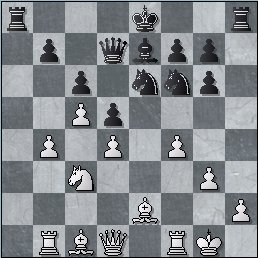
An unexpectedly subtle and probably strong move in a position where straightforward 17...0-0 could have been expected. I like this move regardless of it actual strength for its multipurposeness. Black defends against immediate b4-b5: 18.b5? Nxc5!, black controls xd5 square and possible Nf6-e4 can no more be met with Nc3xe4 and d4-d5, while the remaining knight can be transferred to d5 via c7, and should "b" pawns be exchanged in the future, Bd8-a5 manouevre can not surprise us.
18.Qd3 Ne4 19.Nxe4 dxe4 20.Qxe4 Qxd4+ 21.Qxd4 Nxd4 22.Bc4 0-0
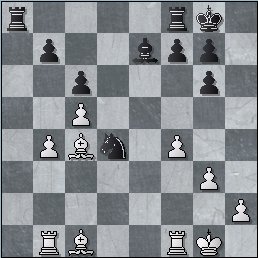
Facing prospects of havnig strongly suppressed position against such a prompt opponent, Kramnik decices to clarify a position as early as possible and simplifies to a wiorse ending where he hopes to compensate white's two bishops with activity of his pieces. Yet if he doesn't get enough counterplay, the drawbacks of his pawn structure will make his position close to hopeless.
23.Kg2 Ra4 24.Rd1 Rd8 25.Be3 Black should be careful with any simplification in this position. Penetration of white's rook's to the 7th rank being a permanent and clear threat, the exchange of all the rooks results in a structurally bad position. 25...Nf5 26.Rxd8+ Bxd8 27.Bf2 Bf6 looks unpleasant for black, because transferring the knight to d5 after Bxd5 brings no relief. Tactical 25...Nc2 needs to be checked: 26.Rxd8+ Bxd8 27.Bf2 Nxb4 (the minor pieces endgame is bad for black: 27...Na3 28.Bb3 Nxb1 29.Bxa4 Nc3 30.Bb3 and even 30...g5 brings no improvement of structure after 31.f5) 28.Bb3! (28.Rd1 Bf6 29.Rd7 Nd5 30.Bxd5 cxd5 and black can survive after any of taking: 31.Rxb7 or 31.Rxd5 ) 28...Ra7 29.Bxf7+ Kxf7 30.Rxb4 g5! white is better but black can hold in the simplified position. Of course, black may try to keep the pieces on the board by 25...Bf6
25...Bf6 26.g4 [26.Bf2 Kf8 followed by Nd4-e6 changed nothing] 26...Kf8 27.Bf2 Ne6 28.Rxd8+ Bxd8 As compared to 25...Nf5 black has better pieces coordinatioon and the king closer to the center. 29.f5?! White is trying to break the interaction of black minor pieces, but after 29...gxf5 30.gxf5 Ng5 with the Ng5-e4-(f6) things for black hardly go worse than before. 29... gxf5 30.gxf5
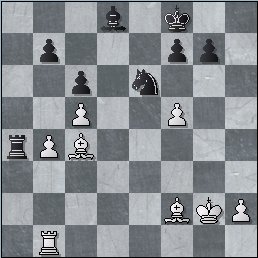
30...Nf4 31.Kf3 Nh5 32.Rb3 Bc7 33.h4 Nf6 Nf6-d7-e5 is to follow. 34.Bd3 Nd7 35.Be4 Ne5 36.Kg2 Ra2 The results of white's swiftness are obvious. It's already white who is defending. 37.Bb1 Rd2 38.Kf1 Ng4 Now 39.Be1 Rh2 40.b5 can be recommended.
39.Bg1 Obviously, white is trying to get rid of black's rook on the 2nd rank after for example 39...Ke7 40.Ke1 Rg2 41.Kf1 But after 39...Bh2! white is going to have difficyulties defending his weak pawns. Yet to be fair let's mention, that 39.Be1 spared white form no difficulties at all. Black has got 39...Nh2 40.Kg1 Re2 and now after 41.Bg3 Bg3 42.Rg3 Rb1 white has a difficult rook endgame, after 41.Bc3 Nf4 the king gets aunder attack, and 41.Bf2 Ng4 42.Bd4 after, for example, 42...Be5 definitely isn't better then the game. 39...Bh2 40.Ke1
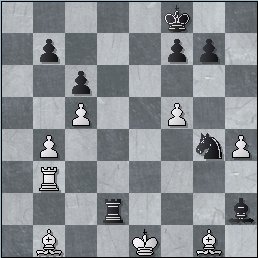
40...Rd5 After suggesting itself 40...Rg2 white could fight for counterplay with a pawn sacrifice: 41.Bd4 Be5 42.Be4 Rh2 43.Bg1 Rh4 44.b5
41.Bf2 41.Bxh2 seems to have led to a forced draw: 41...Nxh2 42.Rd3! Rxd3 (black cannot decline the exchange, after 42...Re5+ 43.Kf2 he has too many targetrs to defend: b7 and g7 pawns, and the knight on h2!) 43.Bxd3 and the position is drawn whether black takes the pawn by 43...Nf3+44.Kf2 Nxh4 45.Kg3 g5 46.Kg4 f6 47.Be4 followed by Be4-h1-e4 or decline it with 43...Ng4 44.Ke2 Ke7 45.Kf3 41...Ke7 42.h5 Nxf2 43.Kxf2 Kf6 44.Kf3

If black now could find some means to defend against b4-b5 supported with Bb1-e4, he would probably reach the opposite coloured bishops endging with rooks and 2 pawns against one on the kingside as the maximum. I doubt there are chances to get it.44...Rd4 45.b5 Rc4 46.bxc6 bxc6 47.Rb6 Rxc5 48.Be4 Kg5 49.Rxc6 Ra5 50.Rb6 Ra3 51.Kg2 Bc7 52.Rb7 Rc3 It still takes precision from white to hold the pawns, now 53.Bd5 leads to draw. However black will try chances anyway, h5 pawn falls.
53.Kf2 Kh5 54.Bd5 f6 55.Ke2
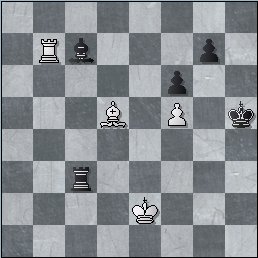
56...Kg4 56.Be4 Kf4 57.Bd3 Rc5 58.Rb4 Kg3 59.Rc4 Re5 60.Re4 Ra5 This kind of positions can be played as long as the rules allow, and however little black's chances may seem, he must play it, try it and enjoy the psychological advantage. Objectively, as long as white's king is not going to be checkmated and dropping f5-pawn is not in white's plans, let's wait for move 105...
61.Re3 Kg2 62.Be4 Kh2 63.Rb3 Ra2 64.Kd3 Bf4 65.Kc4 Re2 66.Kd5
Draw agreed.
----------------------------------------------
Summary
In game 11 of the match Topalov applied a novelty on move 8 that allowed him to obtain some advantage enjoying space and two bishops. Kramnik found a way to force the events and simplified to a worse ending. His opponent played quick but imprecise and as a result even stuck into problems himself. Yet this "popular" in this match course of events had no less traditional final: black's advantage didn't promise real winning chances and the game eventually reached its peaceful end.
